pH-Responsive Nanostructures Based on Surface Active Fatty Acid-Protic Ionic Liquids for Imiquimod Delivery in Skin Cancer Topical Therapy
Abstract
1. Introduction
2. Materials and Methods
2.1. Materials
2.2. Preparation and Characterization of Fatty Acid-Protic Ionic Liquids (FA-PILs)
2.2.1. Preparation of FA-PILs
2.2.2. NMR Analysis
2.2.3. Differential Scanning Calorimetry (DSC)
2.2.4. Surface Tension Measurements
2.3. Preparation and Physico-Chemical Characterization of Self-Assembling Micelles
2.4. In Vitro Release of IMQ from Polymeric Micelles
2.5. In Vitro Cytotoxicity Analysis
2.6. In Vitro Cutaneous Permeation and Distribution Studies
2.7. Storage Stability of IMQ-Loaded FA-PILs-TPGS Mixed Nanostructures
2.8. HPLC Analysis
2.9. Data Analysis
3. Results and Discussion
3.1. Preparation and Characterization of Fatty Acid-Protic Ionic Liquids (FA-PILs)
3.1.1. NMR Analysis
3.1.2. Differential Scanning Calorimetry (DSC)
3.1.3. Surface Tension Measurements
3.2. Preparation and Characterization of Self-Assembling Nanostructures
3.3. pH-Dependent Release of IMQ from the Nanostructures
3.4. In Vitro Cell Viability
3.5. In Vitro Cutaneous Permeation and Distribution Studies of the Selected Formulation
3.6. Storage Stability of the IMQ-Loaded FA-PILs-TPGS Mixed Nanostructures Selected
4. Conclusions
Supplementary Materials
Author Contributions
Funding
Conflicts of Interest
References
- Zhao, B.; He, Y.-Y. Recent advances in the prevention and treatment of skin cancer using photodynamic therapy. Expert Rev. Anticancer Ther. 2010, 10, 1797–1809. [Google Scholar] [CrossRef] [PubMed]
- Fleury, S.; Vianna Lopez, R.F. Topical administration of anticancer drugs for skin cancer treatment. In Skin Cancers–Risk Factors, Prevention and Therapy; La Porta, C., Ed.; InTech: London, UK, 2011. [Google Scholar]
- Lee, C.-H.; Lai, P.-S.; Lu, Y.-P.; Chen, H.-Y.; Chai, C.-Y.; Tsai, R.-K.; Fang, K.-T.; Tsai, M.-H.; Hsu, C.-Y.; Hung, C.-C.; et al. Real-time vascular imaging and photodynamic therapy efficacy with micelle-nanocarrier delivery of chlorin e6 to the microenvironment of melanoma. J. Dermatol. Sci. 2015, 80, 124–132. [Google Scholar] [CrossRef] [PubMed]
- Naidoo, C.; Kruger, C.A.; Abrahamse, H. Photodynamic Therapy for Metastatic Melanoma Treatment: A Review. Technol. Cancer Res. Treat. 2018, 17. [Google Scholar] [CrossRef]
- Singh, S.; Zafar, A.; Khan, S.; Naseem, I. Towards therapeutic advances in melanoma management: An overview. Life Sci. 2017, 174, 50–58. [Google Scholar] [CrossRef] [PubMed]
- Najem, A.; Krayem, M.; Perdrix, A.; Kerger, J.; Awada, A.; Journe, F.; Ghanem, G.E. New Drug Combination Strategies in Melanoma: Current Status and Future DirectionsNew Drug Combination Strategies in Melanoma: Current Status and Future Directions. Anticancer Res. 2017, 37, 5941–5953. [Google Scholar] [CrossRef]
- Pinho, J.O.; Matias, M.; Gaspar, M. Emergent Nanotechnological Strategies for Systemic Chemotherapy against Melanoma. Nanomaterials 2019, 9, 1455. [Google Scholar] [CrossRef] [PubMed]
- NCCN Clinical Practice Guidelines in Oncology (NCCN Guidelines®) for Cutaneous Melanoma (Version 4.2020). Available online: http://www.nccn.org (accessed on 30 October 2020).
- Gabriel, E.; Skitzki, J.J. The Role of Regional Therapies for in-Transit Melanoma in the Era of Improved Systemic Options. Cancers 2015, 7, 1154–1177. [Google Scholar] [CrossRef]
- Dianzani, C.; Zara, G.P.; Maina, G.; Pettazzoni, P.; Pizzimenti, S.; Rossi, F.; Gigliotti, C.L.; Ciamporcero, E.S.; Daga, M.; Barrera, G. Drug Delivery Nanoparticles in Skin Cancers. BioMed Res. Int. 2014, 2014, 895986. [Google Scholar] [CrossRef]
- Naves, L.B.; Dhand, C.; Venugopal, J.R.; Rajamani, L.; Ramakrishna, S.; Almeida, L. Nanotechnology for the treatment of melanoma skin cancer. Prog. Biomater. 2017, 6, 13–26. [Google Scholar] [CrossRef]
- Fernandes, A.R.; Santos, A.C.; Sánchez-López, E.; Kovačević, A.B.; Espina, M.; Calpena, A.C.; Veiga, F.J.; García, M.L.; Souto, E.B. Neoplastic Multifocal Skin Lesions: Biology, Etiology, and Targeted Therapies for Nonmelanoma Skin Cancers. Ski. Pharmacol. Physiol. 2017, 31, 59–73. [Google Scholar] [CrossRef]
- Haque, T.; Rahman, K.M.; Thurston, D.E.; Hadgraft, J.; Lane, M.E. Topical therapies for skin cancer and actinic keratosis. Eur. J. Pharm. Sci. 2015, 77, 279–289. [Google Scholar] [CrossRef] [PubMed]
- Terreni, E.; Chetoni, P.; Tampucci, S.; Burgalassi, S.; Al-Kinani, A.A.; Alany, R.G.; Monti, D. Assembling Surfactants-Mucoadhesive Polymer Nanomicelles (ASMP-Nano) for Ocular Delivery of Cyclosporine-A. Pharmaceutics 2020, 12, 253. [Google Scholar] [CrossRef] [PubMed]
- Dwivedi, A.; Mazumder, A.; Fox, L.T.; Brümmer, A.; Gerber, M.; Du Preez, J.L.; Haynes, R.K.; Du Plessis, J. In vitro skin permeation of artemisone and its nano-vesicular formulations. Int. J. Pharm. 2016, 503, 1–7. [Google Scholar] [CrossRef] [PubMed]
- Telò, I.; Del Favero, E.; Cantù, L.; Frattini, N.; Pescina, S.; Padula, C.; Santi, P.; Sonvico, F.; Nicoli, S. Gel-like TPGS-Based Microemulsions for Imiquimod Dermal Delivery: Role of Mesostructure on the Uptake and Distribution into the Skin. Mol. Pharm. 2017, 14, 3281–3289. [Google Scholar] [CrossRef] [PubMed]
- Tampucci, S.; Carpi, S.; Digiacomo, M.; Polini, B.; Fogli, S.; Burgalassi, S.; Macchia, M.; Nieri, P.; Manera, C.; Monti, D. Diclofenac-Derived Hybrids for Treatment of Actinic Keratosis and Squamous Cell Carcinoma. Molecules 2019, 24, 1793. [Google Scholar] [CrossRef]
- Vogt, A.; Wischke, C.; Neffe, A.T.; Ma, N.; Alexiev, U.; Lendlein, A. Nanocarriers for drug delivery into and through the skin—Do existing technologies match clinical challenges? J. Control. Release 2016, 242, 3–15. [Google Scholar] [CrossRef]
- Wang, Z.; Deng, X.; Ding, J.; Zhou, W.; Zheng, X.; Tang, G. Mechanisms of drug release in pH-sensitive micelles for tumour targeted drug delivery system: A review. Int. J. Pharm. 2018, 535, 253–260. [Google Scholar] [CrossRef]
- Sahu, P.; Kashaw, S.K.; Sau, S.; Jain, S.; Jain, S.; Agrawal, R.K.; Iyer, A.K. pH triggered and charge attracted nanogel for simultaneous evaluation of penetration and toxicity against skin cancer: In-vitro and ex-vivo study. Int. J. Biol. Macromol. 2019, 128, 740–751. [Google Scholar] [CrossRef]
- Bao, Y.; Yin, M.; Hu, X.; Zhuang, X.; Sun, Y.; Guo, Y.; Tan, S.; Zhang, Z. A safe, simple and efficient doxorubicin prodrug hybrid micelle for overcoming tumor multidrug resistance and targeting delivery. J. Control. Release 2016, 235, 182–194. [Google Scholar] [CrossRef]
- Tang, H.; Zhao, W.; Yu, J.; Li, M.; Zhao, C. Recent Development of pH-Responsive Polymers for Cancer Nanomedicine. Molecules 2018, 24, 4. [Google Scholar] [CrossRef]
- Sahu, P.; Kashaw, S.K.; Sau, S.; Kushwah, V.; Jain, S.; Agrawal, R.K.; Iyer, A.K. pH Responsive 5-Fluorouracil Loaded Biocompatible Nanogels For Topical Chemotherapy of Aggressive Melanoma. Colloids Surf. B Biointerfaces 2019, 174, 232–245. [Google Scholar] [CrossRef]
- Ingrosso, F.; Ruiz-López, M.F. Modeling Solvation in Supercritical CO2. ChemPhysChem 2017, 18, 2560–2572. [Google Scholar] [CrossRef] [PubMed]
- Rocco, D.; Chiarotto, I.; D’Anna, F.; Mattiello, L.; Pandolfi, F.; Rizzo, C.; Feroci, M. Cathodic Behaviour of Dicationic Imidazolium Bromides: The Role of the Spacer. ChemElectroChem 2019, 6, 4275–4283. [Google Scholar] [CrossRef]
- Mezzetta, A.; Pomelli, C.S.; Koutsoumpos, S.; Papamichael, M.; Giannios, P.; Moutzouris, K. Temperature effects on the viscosity and the wavelength-dependent refractive index of imidazolium-based ionic liquids with a phosphorus-containing anion. Phys. Chem. Chem. Phys. 2017, 19, 8201–8209. [Google Scholar] [CrossRef]
- Sernaglia, M.; Blanco, D.; Battez, A.H.; Viesca, J.; González, R.; Bartolomé, M. Two fatty acid anion-based ionic liquids—Part I: Physicochemical properties and tribological behavior as neat lubricants. J. Mol. Liq. 2020, 305, 112827. [Google Scholar] [CrossRef]
- Asim, A.M.; Uroos, M.; Naz, S.; Sultan, M.; Griffin, G.; Muhammad, N.; Khan, A.S. Acidic ionic liquids: Promising and cost-effective solvents for processing of lignocellulosic biomass. J. Mol. Liq. 2019, 287, 110943. [Google Scholar] [CrossRef]
- Keaveney, S.T.; Haines, R.S.; Harper, J.B. Ionic liquid solvents: The importance of microscopic interactions in predicting organic reaction outcomes. Pure Appl. Chem. 2017, 89, 745–757. [Google Scholar] [CrossRef][Green Version]
- Morais, E.S.; Lopes, A.M.D.C.; Freire, M.G.; Freire, C.S.R.; Coutinho, J.A.P.; Silvestre, A.J.D. Use of Ionic Liquids and Deep Eutectic Solvents in Polysaccharides Dissolution and Extraction Processes towards Sustainable Biomass Valorization. Molecules 2020, 25, 3652. [Google Scholar] [CrossRef]
- Amiril, S.; Rahim, E.; Syahrullail, S. A review on ionic liquids as sustainable lubricants in manufacturing and engineering: Recent research, performance, and applications. J. Clean. Prod. 2017, 168, 1571–1589. [Google Scholar] [CrossRef]
- Francis, C.F.J.; Kyratzis, I.L.; Best, A.S. Lithium-Ion Battery Separators for Ionic-Liquid Electrolytes: A Review. Adv. Mater. 2020, 32, e1904205. [Google Scholar] [CrossRef]
- Egorova, K.S.; Gordeev, E.G.; Valentine, P.A. Biological Activity of Ionic Liquids and Their Application in Pharmaceutics and Medicine. Chem. Rev. 2017, 117, 7132–7189. [Google Scholar] [CrossRef] [PubMed]
- Niemczak, M.; Rzemieniecki, T.; Sobiech, Ł.; Skrzypczak, G.; Praczyk, T.; Pernak, J. Influence of the alkyl chain length on the physicochemical properties and biological activity in a homologous series of dichlorprop-based herbicidal ionic liquids. J. Mol. Liq. 2019, 276, 431–440. [Google Scholar] [CrossRef]
- Teixeira, S.; Santos, M.M.; Ferraz, R.; Prudêncio, C.; Fernandes, M.H.; Costa-Rodrigues, J.; Branco, L.C. A Novel Approach for Bisphosphonates: Ionic Liquids and Organic Salts from Zoledronic Acid. ChemMedChem 2019, 14, 1767–1770. [Google Scholar] [CrossRef] [PubMed]
- Teixeira, S.; Santos, M.M.; Fernandes, M.H.; Costa-Rodrigues, J.; Branco, L.C. Alendronic Acid as Ionic Liquid: New Perspective on Osteosarcoma. Pharmaceutics 2020, 12, 293. [Google Scholar] [CrossRef]
- Florindo, C.; Costa, A.; Matos, C.; Nunes, S.L.; Matias, A.; Duarte, C.M.; Rebelo, L.P.N.; Branco, L.C.; Marrucho, I.M. Novel organic salts based on fluoroquinolone drugs: Synthesis, bioavailability and toxicological profiles. Int. J. Pharm. 2014, 469, 179–189. [Google Scholar] [CrossRef]
- Abednejad, A.; Ghaee, A.; Morais, E.S.; Sharma, M.; Neves, B.M.; Freire, M.G.; Nourmohammadi, J.; Mehrizi, A.A. Polyvinylidene fluoride–Hyaluronic acid wound dressing comprised of ionic liquids for controlled drug delivery and dual therapeutic behavior. Acta Biomater. 2019, 100, 142–157. [Google Scholar] [CrossRef]
- Chantereau, G.; Sharma, M.; Abednejad, A.; Vilela, C.; Costa, E.; Veiga, M.; Antunes, F.; Pintado, M.; Sèbe, G.; Coma, V.; et al. Bacterial nanocellulose membranes loaded with vitamin B-based ionic liquids for dermal care applications. J. Mol. Liq. 2020, 302, 112547. [Google Scholar] [CrossRef]
- Szepiński, E.; Smolarek, P.; Milewska, M.J.; Łuczak, J. Application of surface active amino acid ionic liquids as phase-transfer catalyst. J. Mol. Liq. 2020, 303, 112607. [Google Scholar] [CrossRef]
- Ali, K.; Moshikur, R.M.; Wakabayashi, R.; Tahara, Y.; Moniruzzaman, M.; Kamiya, N.; Goto, M. Synthesis and characterization of choline–fatty-acid-based ionic liquids: A new biocompatible surfactant. J. Colloid Interface Sci. 2019, 551, 72–80. [Google Scholar] [CrossRef]
- Ali, K.; Moshikur, R.M.; Wakabayashi, R.; Moniruzzaman, M.; Kamiya, N.; Goto, M. Biocompatible Ionic Liquid Surfactant-Based Microemulsion as a Potential Carrier for Sparingly Soluble Drugs. ACS Sustain. Chem. Eng. 2020, 8, 6263–6272. [Google Scholar] [CrossRef]
- Keshapolla, D.; Srinivasarao, K.; Gardas, R.L. Influence of temperature and alkyl chain length on physicochemical properties of trihexyl- and trioctylammonium based protic ionic liquids. J. Chem. Thermodyn. 2019, 133, 170–180. [Google Scholar] [CrossRef]
- Yang, Q.; Ke, Y.; Liu, X.; Yang, Q.; Bao, Z.; Su, B.; Ren, Q.; Yang, Y.; Xing, H. Enhanced self-assembly for the solubilization of cholesterol in molecular solvent/ionic liquid mixtures. Phys. Chem. Chem. Phys. 2017, 19, 10835–10842. [Google Scholar] [CrossRef]
- Oulego, P.; Faes, J.; Gonzalez, R.; Viesca, J.; Blanco, D.; Battez, A.H. Relationships between the physical properties and biodegradability and bacteria toxicity of fatty acid-based ionic liquids. J. Mol. Liq. 2019, 292, 111451. [Google Scholar] [CrossRef]
- Carrión, F.; Avilés, M.; Nakano, K.; Tadokoro, C.; Nagamine, T.; Bermúdez, M. Diprotic ammonium palmitate ionic liquid crystal and nanodiamonds in aqueous lubrication. Film thickness and influence of sliding speed. Wear 2019, 241–252. [Google Scholar] [CrossRef]
- Gusain, R.; Khan, A.; Khatri, O.P. Fatty acid-derived ionic liquids as renewable lubricant additives: Effect of chain length and unsaturation. J. Mol. Liq. 2020, 301, 112322. [Google Scholar] [CrossRef]
- De Faria, E.L.P.; Ferreira, A.M.; Cláudio, A.F.M.; Coutinho, J.A.P.; Silvestre, A.J.D.; Freire, M.G. Recovery of Syringic Acid from Industrial Food Waste with Aqueous Solutions of Ionic Liquids. ACS Sustain. Chem. Eng. 2019, 7, 14143–14152. [Google Scholar] [CrossRef]
- Mezzetta, A.; Guazzelli, L.; Seggiani, M.; Pomelli, C.S.; Puccini, M.; Chiappe, C. A general environmentally friendly access to long chain fatty acid ionic liquids (LCFA-ILs). Green Chem. 2017, 19, 3103–3111. [Google Scholar] [CrossRef]
- Mezzetta, A.; Perillo, V.; Guazzelli, L.; Chiappe, C. Thermal behavior analysis as a valuable tool for comparing ionic liquids of different classes. J. Therm. Anal. Calorim. 2019, 138, 3335–3345. [Google Scholar] [CrossRef]
- Sahbaz, Y.; Williams, H.D.; Nguyen, T.-H.; Saunders, J.; Ford, L.; Charman, S.A.; Scammells, P.J.; Porter, C.J. Transformation of Poorly Water-Soluble Drugs into Lipophilic Ionic Liquids Enhances Oral Drug Exposure from Lipid Based Formulations. Mol. Pharm. 2015, 12, 1980–1991. [Google Scholar] [CrossRef]
- Jin, W.; Yang, Q.; Zhang, Z.; Bao, Z.; Ren, Q.; Xing, H. Self-assembly induced solubilization of drug-like molecules in nanostructured ionic liquids. Chem. Commun. 2015, 51, 13170–13173. [Google Scholar] [CrossRef]
- Panda, S.; Kundu, K.; Basaiahgari, A.; Singh, A.P.; Senapati, S.; Gardas, R.L. Aggregation behaviour of biocompatible choline carboxylate ionic liquids and their interactions with biomolecules through experimental and theoretical investigations. New J. Chem. 2018, 42, 7105–7118. [Google Scholar] [CrossRef]
- Williams, H.D.; Ford, L.; Lim, S.; Han, S.; Baumann, J.; Sullivan, H.; Vodak, D.; Igonin, A.; Benameur, H.; Pouton, C.W.; et al. Transformation of Biopharmaceutical Classification System Class I and III Drugs Into Ionic Liquids and Lipophilic Salts for Enhanced Developability Using Lipid Formulations. J. Pharm. Sci. 2018, 107, 203–216. [Google Scholar] [CrossRef] [PubMed]
- Greaves, T.L.; Drummond, C.J. Protic Ionic Liquids: Evolving Structure–Property Relationships and Expanding Applications. Chem. Rev. 2015, 115, 11379–11448. [Google Scholar] [CrossRef] [PubMed]
- Becherini, S.; Mezzetta, A.; Chiappe, C.; Guazzelli, L. Levulinate amidinium protic ionic liquids (PILs) as suitable media for the dissolution and levulination of cellulose. New J. Chem. 2019, 43, 4554–4561. [Google Scholar] [CrossRef]
- Shen, X.; Chen, Q.; Zhang, J.; Fu, P. Supramolecular Structures in the Presence of Ionic Liquids. In Ionic Liquids: Theory, Properties, New Approaches; Kokorin, A., Ed.; InTech: Rijeka, Croatia, 2011; pp. 427–482. [Google Scholar] [CrossRef][Green Version]
- Yang, C.; Wu, T.; Qi, Y.; Zhang, Z. Recent Advances in the Application of Vitamin E TPGS for Drug Delivery. Theranostics 2018, 8, 464–485. [Google Scholar] [CrossRef]
- Micali, G.; Lacarrubba, F.; Nasca, M.R.; Schwartz, R.A. Topical pharmacotherapy for skin cancer: Part I. Pharmacology. J. Am. Acad. Dermatol. 2014, 70, 965.e1-12. [Google Scholar] [CrossRef]
- Lapteva, M.; Mignot, M.; Mondon, K.; Möller, M.; Gurny, R.; Kalia, Y.N. Self-assembled mPEG-hexPLA polymeric nanocarriers for the targeted cutaneous delivery of imiquimod. Eur. J. Pharm. Biopharm. 2019, 142, 553–562. [Google Scholar] [CrossRef]
- Bong, A.B.; Bonnekoh, B.; Franke, I.; Schön, M.P.; Ulrich, J.; Gollnick, H. Imiquimod, a topical immune response modifier, in the treatment of cutaneous metastases of malignant melanoma. Dermatology 2002, 205, 135–138. [Google Scholar] [CrossRef]
- Urosevic, M.; Dummer, R. Role of Imiquimod in Skin Cancer Treatment. Am. J. Clin. Dermatol. 2004, 5, 453–458. [Google Scholar] [CrossRef]
- Burns, C.A.; Brown, M.D. Imiquimod for the treatment of skin cancer. Dermatol. Clin. 2005, 23, 151–164. [Google Scholar] [CrossRef]
- Aspord, C.; Tramcourt, L.; Leloup, C.; Molens, J.-P.; Leccia, M.-T.; Charles, J.; Plumas, J. Imiquimod Inhibits Melanoma Development by Promoting pDC Cytotoxic Functions and Impeding Tumor Vascularization. J. Investig. Dermatol. 2014, 134, 2551–2561. [Google Scholar] [CrossRef] [PubMed]
- Carpi, S.; Polini, B.; Manera, C.; Digiacomo, M.; Salsano, J.E.; Macchia, M.; Scoditti, E.; Nieri, P. MiRNA modulation and antitumor activity by the extra-virgin olive oil polyphenol oleacein in human melanoma cells. Front. Pharmacol. 2020, 11, 574317. [Google Scholar] [CrossRef] [PubMed]
- Monti, D.; Chetoni, P.; Burgalassi, S.; Tampucci, S.; Centini, M.; Anselmi, C. 4-Methylbenzylidene camphor microspheres: Reconstituted epidermis (Skinethic®) permeation and distribution. Int. J. Cosmet. Sci. 2015, 37, 298–305. [Google Scholar] [CrossRef]
- Burgalassi, S.; Monti, D.; Nicosia, N.; Tampucci, S.; Terreni, E.; Vento, A.; Chetoni, P. Freeze-dried matrices for ocular administration of bevacizumab: A comparison between subconjunctival and intravitreal administration in rabbits. Drug Deliv. Transl. Res. 2018, 8, 461–472. [Google Scholar] [CrossRef]
- Tampucci, S.; Terreni, E.; Burgalassi, S.; Chetoni, P.; Monti, D. Development and Validation of an HPLC–UV Method to Quantify Tavaborole During in Vitro Transungual Permeation Studies. J. AOAC Int. 2018, 101, 437–443. [Google Scholar] [CrossRef]
- Ahmad, Z.; Shah, A.; Siddiq, M.; Kraatz, H.-B. Polymeric micelles as drug delivery vehicles. RSC Adv. 2014, 4, 17028–17038. [Google Scholar] [CrossRef]
- Gómez, E.; Calvar, N.; Domínguez, Á.; Macedo, E.A. Thermal behavior and heat capacities of pyrrolidinium-based ionic liquids by DSC. Fluid Phase Equilib. 2018, 470, 51–59. [Google Scholar] [CrossRef]
- Gómez, E.; Requejo, P.F.; Domínguez, Á.; Macedo, E.A. Influence of the alkyl chain cation position on thermal behaviour: (1,2) and (1,4) pyridinium Bis(trifluoromethylsulfonyl)imide—Based ionic liquids. Fluid Phase Equilib. 2020, 519, 112658. [Google Scholar] [CrossRef]
- Rantamäki, A.H.; Ruokonen, S.-K.; Sklavounos, E.; Kyllönen, L.; King, A.; Wiedmer, S.K. Impact of Surface-Active Guanidinium-, Tetramethylguanidinium-, and Cholinium-Based Ionic Liquids on Vibrio Fischeri Cells and Dipalmitoylphosphatidylcholine Liposomes. Sci. Rep. 2017, 7, srep46673. [Google Scholar] [CrossRef]
- Mezzetta, A.; Łuczak, J.; Woch, J.; Chiappe, C.; Nowicki, J.; Guazzelli, L. Surface active fatty acid ILs: Influence of the hydrophobic tail and/or the imidazolium hydroxyl functionalization on aggregates formation. J. Mol. Liq. 2019, 289, 111155. [Google Scholar] [CrossRef]
- May, S.; Ben-Shaul, A. Molecular Theory of the Sphere-to-Rod Transition and the Second CMC in Aqueous Micellar Solutions. J. Phys. Chem. B 2001, 105, 630–640. [Google Scholar] [CrossRef]
- Zhao, M.; Yan, Z.; Dai, C.; Du, M.; Li, H.; Zhao, Y.; Wang, K.; Ding, Q. Formation and rheological properties of wormlike micelles by N-hexadecyl-N-methylpiperidinium bromide and sodium salicylate. Colloid Polym. Sci. 2015, 293, 1073–1082. [Google Scholar] [CrossRef]
- Dong, B.; Li, N.; Zheng, L.; Yu, L.; Inoue, T. Surface Adsorption and Micelle Formation of Surface Active Ionic Liquids in Aqueous Solution. Langmuir 2007, 23, 4178–4182. [Google Scholar] [CrossRef]
- Sharma, R.; Mahajan, S.; Mahajan, R.K. Surface adsorption and mixed micelle formation of surface active ionic liquid in cationic surfactants: Conductivity, surface tension, fluorescence and NMR studies. Colloids Surf. A Physicochem. Eng. Asp. 2013, 427, 62–75. [Google Scholar] [CrossRef]
- Chabba, S.; Kumar, S.; Aswal, V.K.; Kang, T.S.; Mahajan, R.K. Interfacial and aggregation behavior of aqueous mixtures of imidazolium based surface active ionic liquids and anionic surfactant sodium dodecylbenzenesulfonate. Colloids Surf. A Physicochem. Eng. Asp. 2015, 472, 9–20. [Google Scholar] [CrossRef]
- Argenziano, M.; Haimhoffer, A.; Bastiancich, C.; Jicsinszky, L.; Caldera, F.; Trotta, F.; Scutera, S.; Alotto, D.; Fumagalli, M.; Musso, T.; et al. In Vitro Enhanced Skin Permeation and Retention of Imiquimod Loaded in β-Cyclodextrin Nanosponge Hydrogel. Pharmaceutics 2019, 11, 138. [Google Scholar] [CrossRef]
- Castelli, D.D.; Ferrauto, G.; Cutrin, J.C.; Terreno, E.; Aime, S. In vivo maps of extracellular pH in murine melanoma by CEST-MRI. Magn. Reson. Med. 2014, 71, 326–332. [Google Scholar] [CrossRef]
- Rocco, R.; Alegre, N.; Pozner, R.; Wainstok, R.; Gazzaniga, S. Selective hemangioma cell dysfunction and apoptosis triggered by in vitro treatment with imiquimod. Toxicol. Lett. 2018, 288, 82–88. [Google Scholar] [CrossRef]
- Gazzi, R.P.; Frank, L.A.; Onzi, G.; Pohlmann, A.R.; Guterres, S.S. New pectin-based hydrogel containing imiquimod-loaded polymeric nanocapsules for melanoma treatment. Drug Deliv. Transl. Res. 2020, 1–12. [Google Scholar] [CrossRef]
- Courbet, A.; Bec, N.; Constant, C.; Larroque, C.; Pugnière, M.; El Messaoudi, S.; Zghaib, Z.; Khier, S.; Deleuze-Masquefa, C.; Gattacceca, F. Imidazoquinoxaline anticancer derivatives and imiquimod interact with tubulin: Characterization of molecular microtubule inhibiting mechanisms in correlation with cytotoxicity. PLoS ONE 2017, 12, e0182022. [Google Scholar] [CrossRef]
- Frank, L.A.; Gazzi, R.; Mello, P.D.A.; Buffon, A.; Pohlmann, A.R.; Guterres, S.S. Imiquimod-loaded nanocapsules improve cytotoxicity in cervical cancer cell line. Eur. J. Pharm. Biopharm. 2019, 136, 9–17. [Google Scholar] [CrossRef]
- Zagon, I.S.; Donahue, R.N.; Rogosnitzky, M.; McLaughlin, P.J. Imiquimod Upregulates the Opioid Growth Factor Receptor to Inhibit Cell Proliferation Independent of Immune Function. Exp. Biol. Med. 2008, 233, 968–979. [Google Scholar] [CrossRef]
- Moretton, M.A.; Chiappetta, D.A.; Sosnik, A. Cryoprotection–lyophilization and physical stabilization of rifampicin-loaded flower-like polymeric micelles. J. R. Soc. Interface 2011, 9, 487–502. [Google Scholar] [CrossRef]
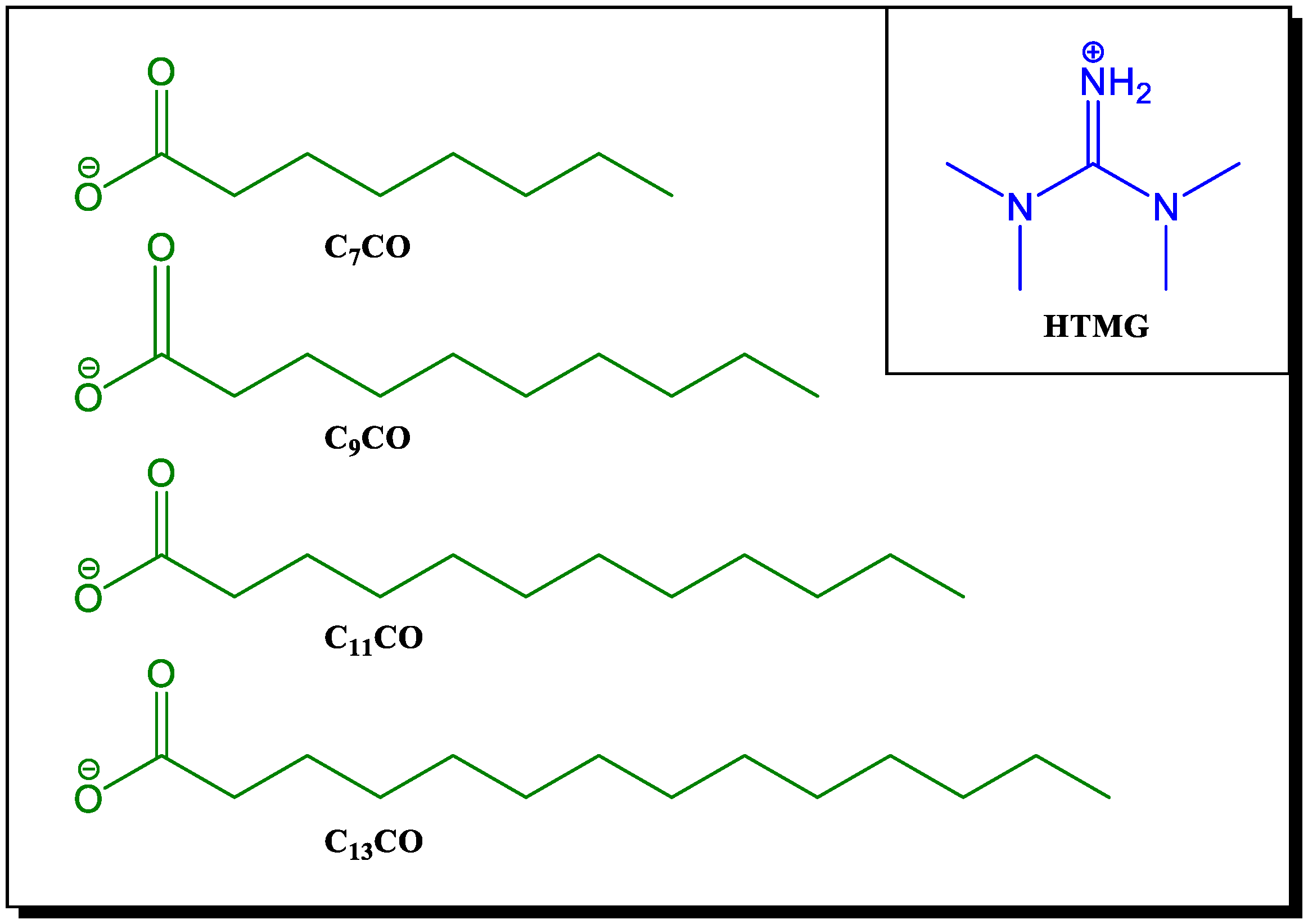


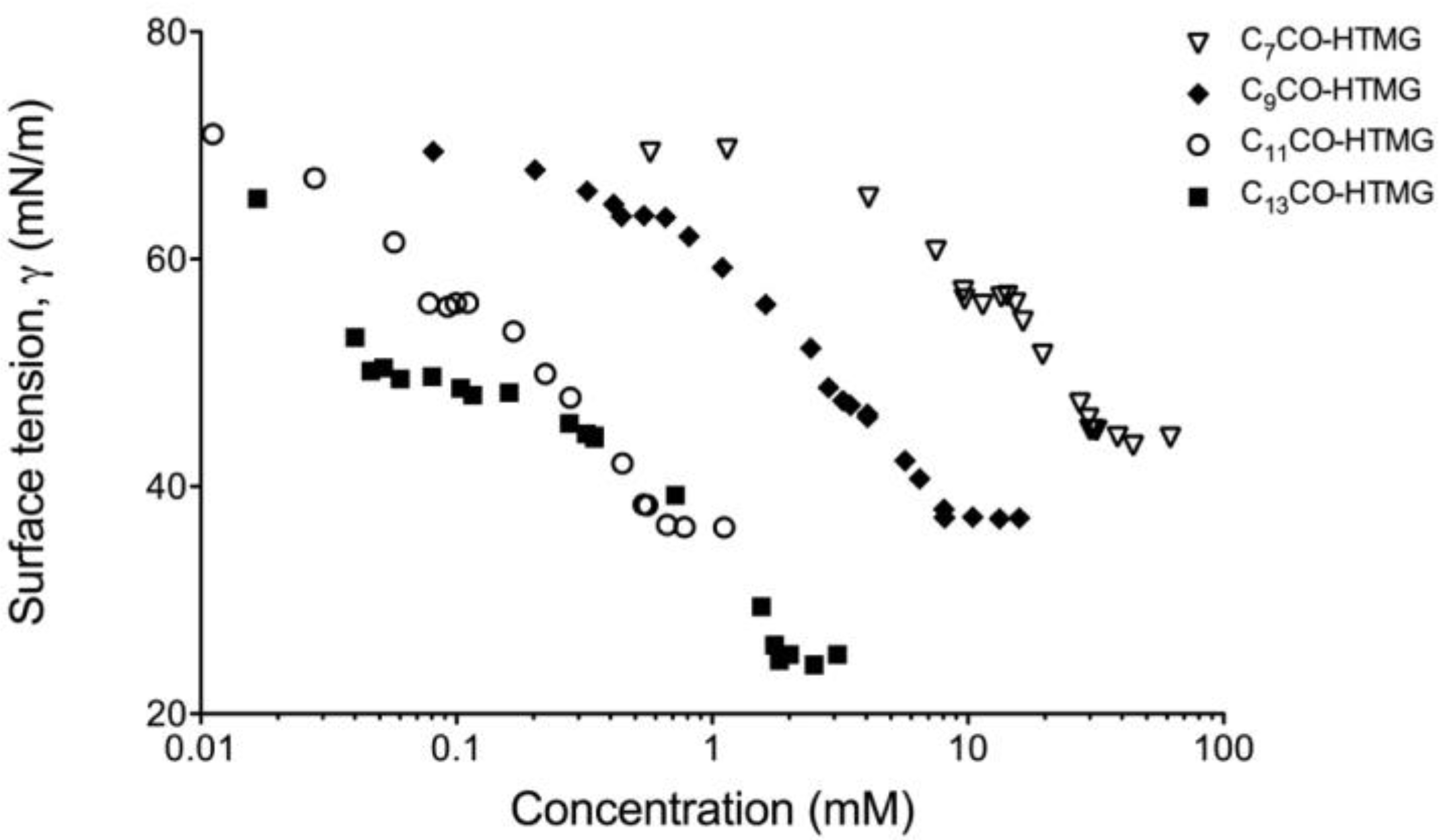
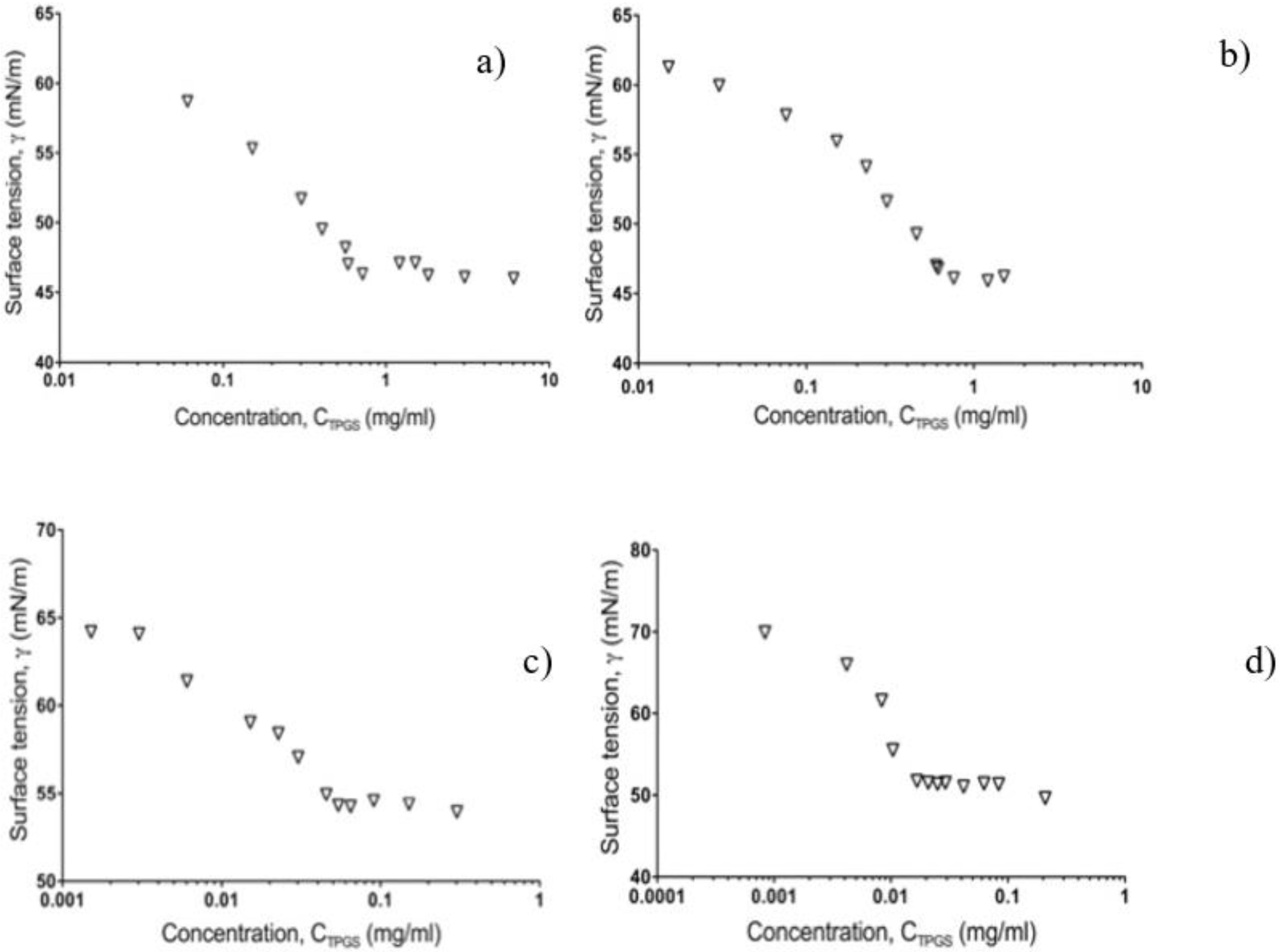
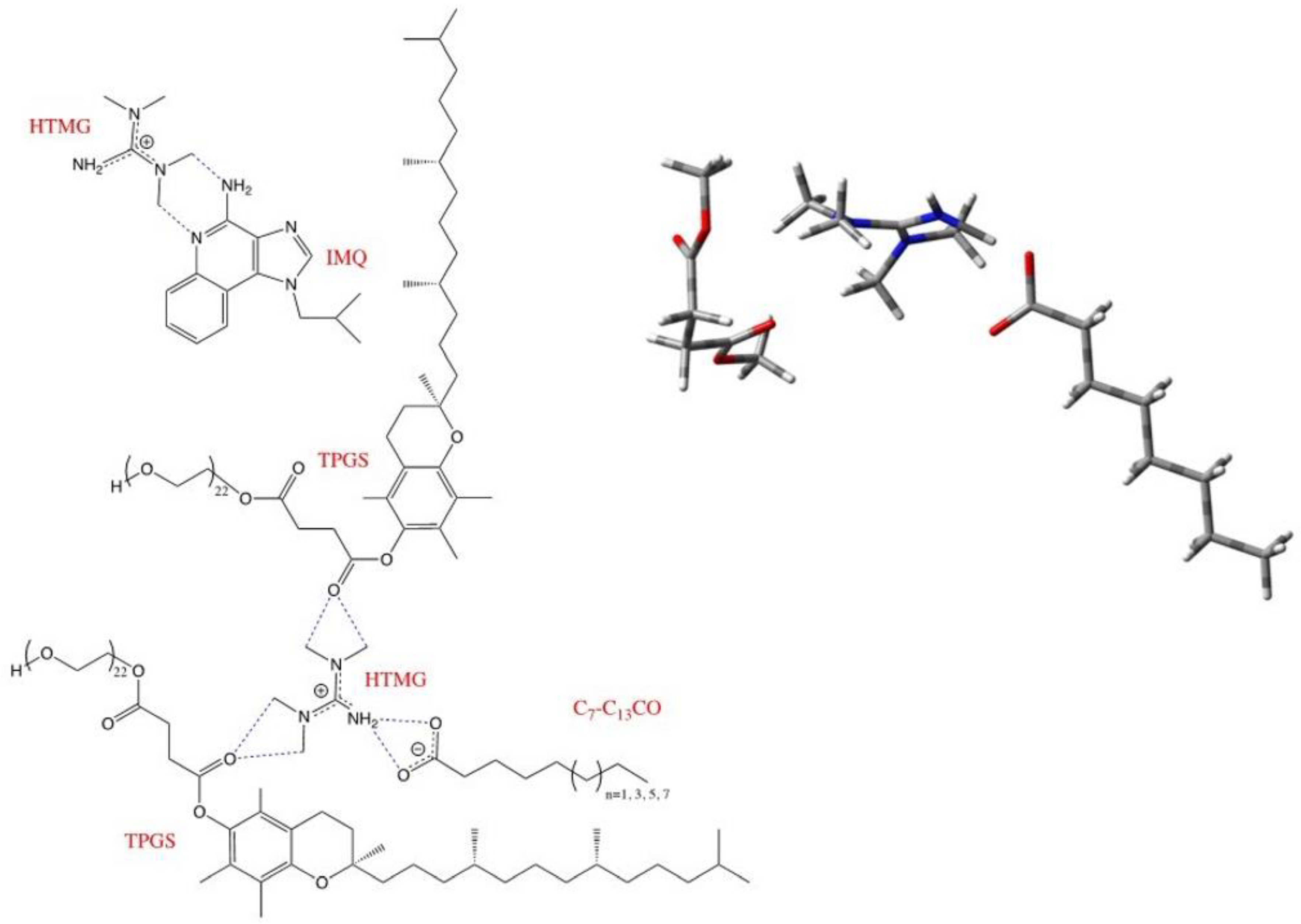

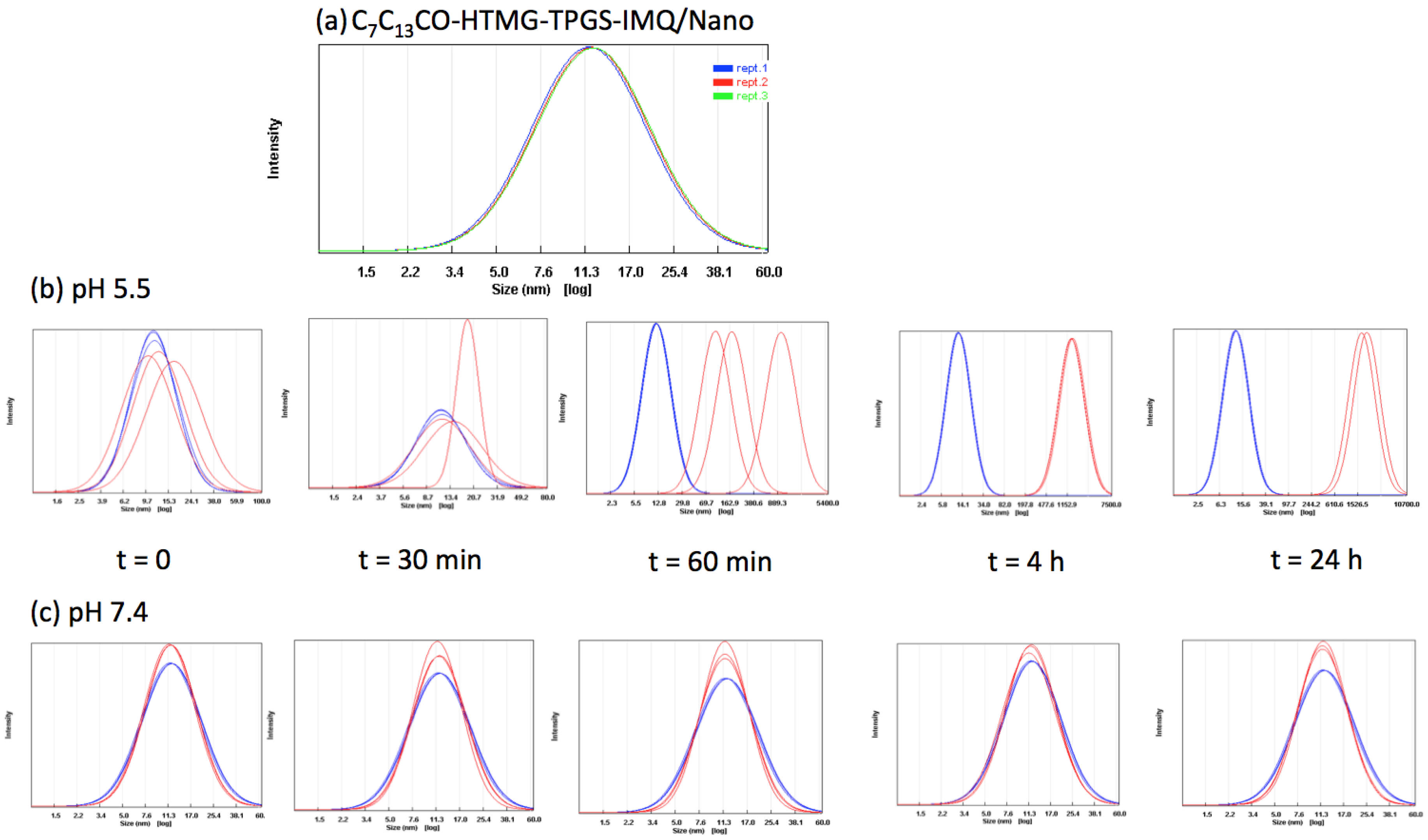
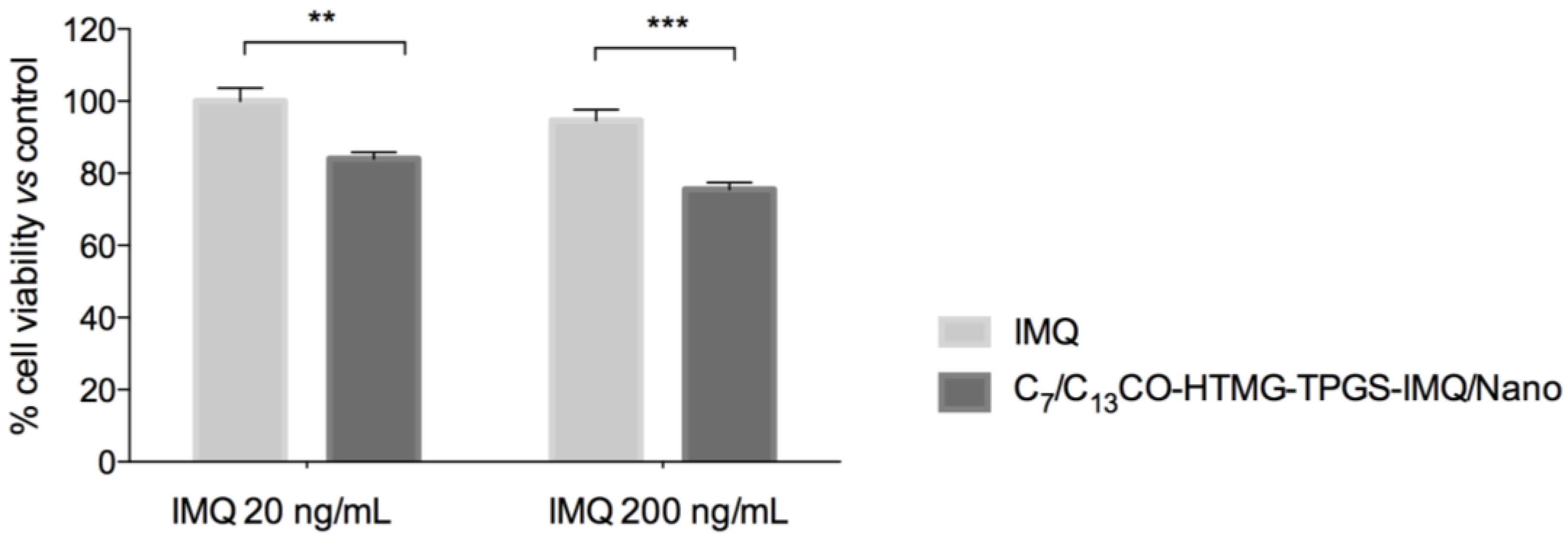
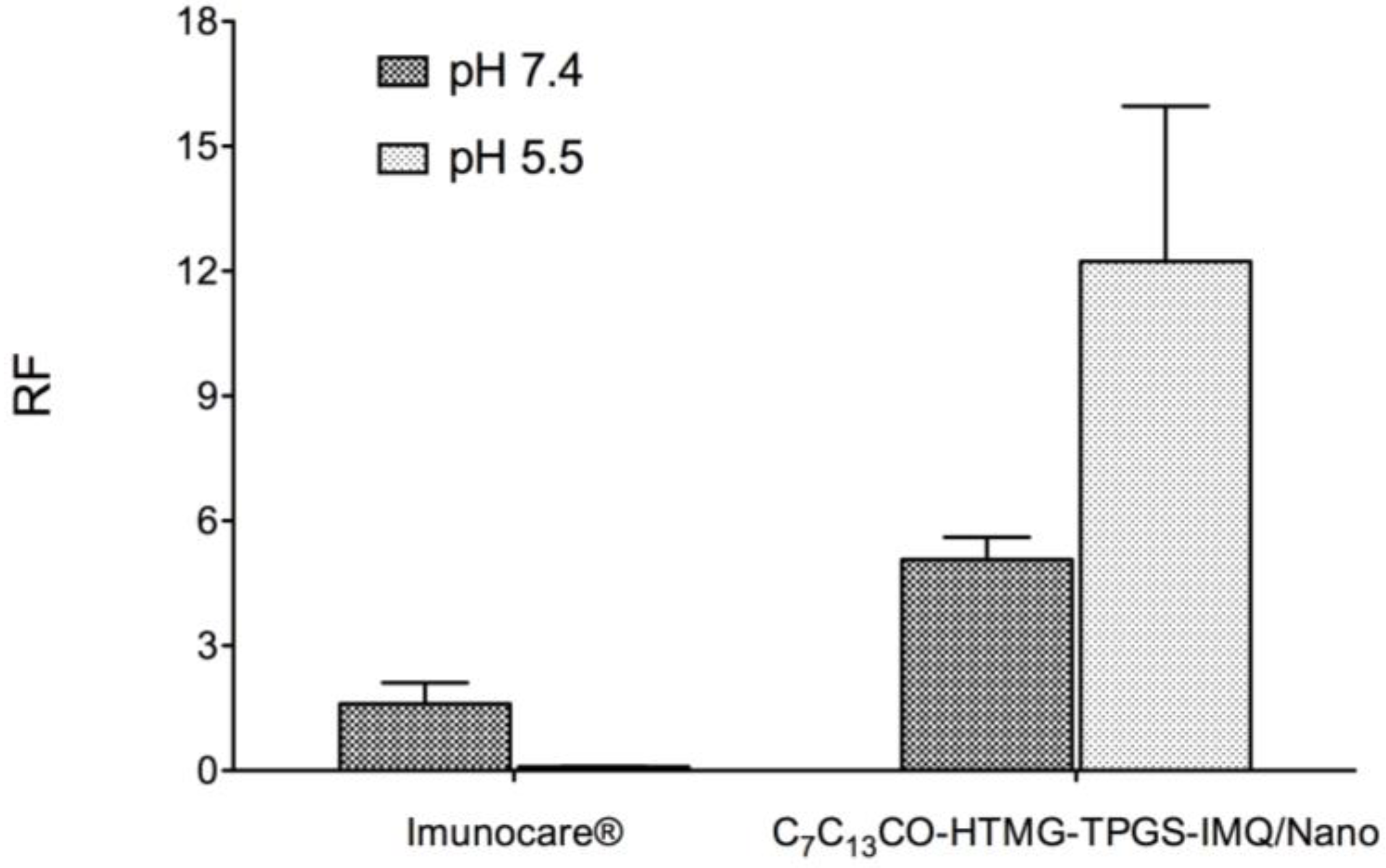
| Anion. | Scanning Rate (°C/min) | Temperature (°C) | |||
|---|---|---|---|---|---|
| Tg | Tc | Tcc | Tm | ||
| C7COO | 2 | −69.7 | -- | -- | -- |
| 5 | −65.5 | -- | 10.7 | 31.7 | |
| 10 | −63.1 | -- | 11.4 | 35.5 | |
| C9COO | 2 | -- | −6.1 | -- | 17.8 |
| −12.8 | 39.6 | ||||
| 5 | -- | 5.8 | -- | 12.9 | |
| −8.1 | 46.7 | ||||
| 10 | -- | 7.6 | -- | 11.6 | |
| −12.4 | 48.6 | ||||
| C11COO | 2 | -- | 13.6 | -- | 36.0 |
| 5 | -- | 9.8 | -- | 36.5 | |
| 4.9 | |||||
| 10 | -- | 8.4 | -- | 33.2 | |
| 2.6 | 36.9 | ||||
| C13COO | 2 | -- | 37.9 | -- | 47.6 |
| 32.9 | 59.7 | ||||
| 5 | -- | 38.4 | -- | 46.7 | |
| 25.9 | 61.7 | ||||
| 10 | -- | 35.9 | 26.4 | 45.7 | |
| 22.0 | 62.2 | ||||
| FA-PIL | cmc1 mM | cmc2 mM | γcmc1 mN/M | γcmc2 mN/M |
|---|---|---|---|---|
| C7CO-HTMG | 9.72 | 30.88 | 56.30 | 45.18 |
| C9CO-HTMG | 0.48 | 7.18 | 63.77 | 37.26 |
| C11CO-HTMG | 0.08 | 0.56 | 55.74 | 37.73 |
| C13CO-HTMG | 0.05 | 1.80 | 49.99 | 25.75 |
| Formulation CnCOPILs/Nano | FA-PIL | Concentration mM | Dh (nm) | P.I. | |||
|---|---|---|---|---|---|---|---|
| 62.6° | 90° | 62.6° | 90° | ||||
| C7CO-HTMG/Nano | C7CO-HTMG | 45.50 | n.d. | 205.1 ± 38.9 | n.d. | 0.709 | |
| C9CO-HTMG/Nano | C9CO-HTMG | 3.688 | 253.5 ± 1.7 | 200.6 ± 12.4 | 0.233 | 0.065 | |
| C11CO-HTMG/Nano | C11CO-HTMG | 0.100 | 236.9 ± 3.5 | 201.9 ± 19.9 | 0.218 | 0.273 | |
| C13CO-HTMG/Nano | C13CO-HTMG | 0.728 | 264.7 ± 1.3 | 226.4 ± 9.31 | 0.124 | 0.158 | |
| Formulation CnCOPILs-TPGS/Nano | FA-PIL mM | TPGS mM | Dh (nm) | P.I. | |||
| 62.6° | 90° | 62.6° | 90° | ||||
| C7CO-HTMG-TPGS/Nano | 25.00 | 25.00 | 13.6 ± 0.4 | 12.0 ± 0.8 | 0.331 | 0.112 | |
| C9CO-HTMG-TPGS Nano | 5.00 | 50.00 | 8.6 ± 0.06 | 7.7 ± 0.3 | 0.440 | 0.351 | |
| C11CO-HTMG-TPGS Nano | 0.40 | 4.00 | 42.4 ± 15.0 | 20.3 ± 0.7 | 1.322 | 1.163 | |
| C13CO-HTMG-TPGS/Nano | 1.455 | 1.455 | 15.5 ± 1.8 | 14.0 ± 1.0 | 0.377 | 0.272 | |
| C7C13CO-HTMG-TPGS/Nano | 25.0 * | 1.455 § | 25.00 | 10.1 ± 0.1 | 10.3± 0.7 | 0.135 | 0.052 |
| Formulation | IMQ mM | Dh (nm) | P.I. | IMQsol mM | EE %w/w | LE %w/w | ||
|---|---|---|---|---|---|---|---|---|
| 62.6° | 90° | 62.6° | 90° | |||||
| C13CO-HTMG-IMQ/Nano | 5.00 | 251.7 ± 5.6 | 206.5 ± 16.9 | 0.245 | 0.270 | 0.036 | 0.72 | 0.60 |
| C13CO-HTMG-TPGS-IMQ/Nano | 5.00 | 269.5 ± 1.4 | 218.7 ± 1.0 | 0.250 | 0.683 | 0.83 | 16.60 | 5.10 |
| C7C13CO-HTMG-TPGS -IMQ/Nano | 5.00 | 13.6 ± 0.2 | 12.3 ± 0.3 | 0.364 | 0.229 | 0.18 | 3.60 | 0.25 |
| Formulation | pH Receiving Phase | J ng/cm2·h | tL h | Q24h g/cm2 | Qskin g/cm3 |
|---|---|---|---|---|---|
| Imunocare® | 7.4 | 7.97 ± 2.53 | 4.24 ± 0.10 | 0.16 ± 0.05 | 73.70 ± 22.81 |
| 5.5 | 86.64 ± 8.21 * | 4.03 ± 0.36 | 1.68 ± 0.13 * | 43.56 ± 2.94 | |
| C7C13CO-HTMG-TPGS-IMQ/Nano | 7.4 | 7.86 ± 0.19 | 4.72 ± 1.95 | 0.15 ± 0.01 | 2.75 ± 0.19 |
| 5.5 | 107.40 ± 16.32 * | 4.47 ± 0.40 | 2.11 ± 0.36 * | 5.93 ± 0.64 * |
| Time | Dh (nm) | P.I. | IMQsol mM | ||
|---|---|---|---|---|---|
| 62.6° | 90° | 62.6° | 90° | ||
| Before freeze-drying | 13.1 ± 0.22 | 12.0 ± 0.24 | 0.47 ± 0.01 | 0.19 ± 0.04 | 0.149 ± 0.021 |
| 0 | 11.8 ± 0.08 | 12.0 ± 0.59 | 0.14 ± 0.01 | 0.08 ± 0.31 | 0.145 ± 0.020 |
| 15 days | 10.2 ± 0.11 | 10.4 ± 0.80 | 0.13 ± 0.03 | 0.21 ± 0.31 | 0.142 ± 0.024 |
| 30 days | 12.2 ± 0.14 | 12.2 ± 1.00 | 0.19 ± 0.03 | 0.03 ± 0.59 | 0.146 ± 0.022 |
Publisher’s Note: MDPI stays neutral with regard to jurisdictional claims in published maps and institutional affiliations. |
© 2020 by the authors. Licensee MDPI, Basel, Switzerland. This article is an open access article distributed under the terms and conditions of the Creative Commons Attribution (CC BY) license (http://creativecommons.org/licenses/by/4.0/).
Share and Cite
Tampucci, S.; Guazzelli, L.; Burgalassi, S.; Carpi, S.; Chetoni, P.; Mezzetta, A.; Nieri, P.; Polini, B.; Pomelli, C.S.; Terreni, E.; et al. pH-Responsive Nanostructures Based on Surface Active Fatty Acid-Protic Ionic Liquids for Imiquimod Delivery in Skin Cancer Topical Therapy. Pharmaceutics 2020, 12, 1078. https://doi.org/10.3390/pharmaceutics12111078
Tampucci S, Guazzelli L, Burgalassi S, Carpi S, Chetoni P, Mezzetta A, Nieri P, Polini B, Pomelli CS, Terreni E, et al. pH-Responsive Nanostructures Based on Surface Active Fatty Acid-Protic Ionic Liquids for Imiquimod Delivery in Skin Cancer Topical Therapy. Pharmaceutics. 2020; 12(11):1078. https://doi.org/10.3390/pharmaceutics12111078
Chicago/Turabian StyleTampucci, Silvia, Lorenzo Guazzelli, Susi Burgalassi, Sara Carpi, Patrizia Chetoni, Andrea Mezzetta, Paola Nieri, Beatrice Polini, Christian Silvio Pomelli, Eleonora Terreni, and et al. 2020. "pH-Responsive Nanostructures Based on Surface Active Fatty Acid-Protic Ionic Liquids for Imiquimod Delivery in Skin Cancer Topical Therapy" Pharmaceutics 12, no. 11: 1078. https://doi.org/10.3390/pharmaceutics12111078
APA StyleTampucci, S., Guazzelli, L., Burgalassi, S., Carpi, S., Chetoni, P., Mezzetta, A., Nieri, P., Polini, B., Pomelli, C. S., Terreni, E., & Monti, D. (2020). pH-Responsive Nanostructures Based on Surface Active Fatty Acid-Protic Ionic Liquids for Imiquimod Delivery in Skin Cancer Topical Therapy. Pharmaceutics, 12(11), 1078. https://doi.org/10.3390/pharmaceutics12111078














